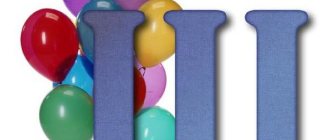The child does not pronounce hissing sounds: exercises for making hissing sounds, articulation gymnastics, tasks for children, video of a speech therapist.
Friends! Today I am pleased to introduce you in this article to speech therapist and defectologist Elena Shmygol. Today she will help you and your children learn how to speak hissing sounds correctly. And if you need Elena’s help, her individual Skype consultation, or you want to personally learn from her how to correctly do the exercises from the article with your child and teach your child to speak correctly with her help, then Elena’s contacts are given at the end of this article.
Correct pronunciation of the sound "sh":
When the sound is sh
pronounced correctly
- lips
are rounded and slightly extended forward; - the teeth
are close together, but not touching; - the tongue
takes the shape of a cup, its tip touching the tubercles behind the upper teeth (alveoli); the air stream is strong, warm, and comes out in the middle of the tongue.
Education w
and
z
differs only in the presence or absence of a voice, that is, the sounds
sh
and
z
are pronounced almost identically, only
sh
is voiceless, and
z
is voiced.
If a child has learned to pronounce the sound sh correctly ,
When you add a voice,
it
will work automatically.
Workshop “Producing sounds [Ш, Ж, Шch] in preschool children”. Consultation on speech therapy
"Municipal autonomous preschool educational institution
"Kindergarten "Rainbow"
Workshop
within the framework of a permanent seminar
teachers-speech therapists of preschool educational institutions of the Sovetsky district
Topic: “Production of sounds [Ш, Ж, Ш, Ш] in preschool children.”
Prepared by a speech therapist teacher
Andronova T. A.
Sovetsky
October 2021
The entire system of speech therapy work on the formation of correct sound pronunciation can be divided into two stages:
- The first stage is preparatory
Main goals:
- development of auditory attention, auditory memory and phonemic perception. Before you start learning to pronounce the sound “s”, you need the child to hear and understand that he is missing this sound;
- elimination of insufficient development of speech motor skills, carrying out preparatory articulation exercises for the development of mobility of the organs of the peripheral speech apparatus.
- Second stage main
Main goals:
- elimination of incorrect sound pronunciation;
- to form the initial skills of correct pronunciation of sounds;
- development in children of the ability to differentiate similar sounds in pronunciation
by articulation or sound;
- formation of pronunciation skills in various types of independent speech of children. Speech therapy work on the formation of correct sound pronunciation is based on the development of new articulation skills by incorporating intact analyzers (visual and auditory perceptions, tactile and kinesthetic sensations) into the work.
Classes to correct pronunciation defects are conducted in a certain sequence:
1) Sound production.
2) Sound automation
3) Differentiation of sounds.
4) Automation of sounds in spoken language.
To produce sounds you need a mirror, a set of probes, spatulas, cotton wool, alcohol, and a set of didactic and illustrative material.
When establishing the correct pronunciation of sounds, three main methods are used.
The first method is based on imitation.
The second method consists of mechanical impact on the speech organs using any devices (probes).
The third method is mixed.
The correct arrangement of the organs of articulation [W, F] (hissing).
The sounds sh and z belong to the group of mid-palatal ones.
When pronouncing the sound sh, the parts of the articulatory apparatus occupy the following position:
- the lips are slightly pushed forward;
- the tip of the tongue is raised to the palate (behind the alveoli), but does not touch it, forming a gap;
- the lateral edges of the tongue are pressed from the inside to the upper molars, not allowing a stream of exhaled air to pass along the sides;
- the velum is raised;
- vocal cords are open.
When pronouncing the sound w, the position of the parts of the articulatory apparatus is the same as when w, only the vocal cords are closed and vibrate: the tongue is raised higher towards the hard palate; the exhaled stream of air is weaker.
The child can feel the vibration of the vocal cords by placing his hand on the speech therapist’s larynx, and then on his own. First, the speech therapist himself must pronounce the sounds sh-zh one by one, while holding the child’s hand on his larynx.
Sound h.
The sound h belongs to the group of affricates (stop-friction). This sound arises as a result of the rapid connection of a stop sound t` followed by a fricative sh`.
When pronouncing the sound h, just as when pronouncing the sound c, two moments are observed: at the first moment, the tip of the tongue makes a bow with the roots of the upper incisors, at the second, the tip of the tongue after the explosion moves back to the alveoli, forming a narrowing here; the whole tongue is tense, close to the palate; lips slightly moved forward; the velum is raised; vocal cords are open.
Sound
The sound u sounds like a long sound [sh`].
When pronouncing it, parts of the articulatory apparatus occupy the following position:
- lips moved forward;
- the tip of the tongue is raised, as with w, but not to the front of the hard palate, but to the alveoli, forming a gap in this place;
- the lateral edges of the tongue adjoin the inner side of the molars, forming a longitudinal channel in the middle of the tongue through which a stream of exhaled air passes; the entire mass of the tongue is tense, the root part is raised;
- the velum is raised.
Types of sigmatism.
Disadvantages in the pronunciation of hissing sounds are called sigmatism; the replacement of whistling sounds with hissing or other sounds of the Russian language is called parasigmatism.
Sigmatism is of the following types:
1. Interdental sigmatism.
This disadvantage is expressed in the fact that when pronouncing whistling or hissing sounds (and sometimes both), the tip of the tongue is pushed between the lower and upper incisors, which results in a lisping sound.
2. Labiodental sigmatism.
With this lack of pronunciation, whistling or hissing sounds (and sometimes both) are pronounced like the sounds f and v, i.e., when the parts of the articulatory apparatus are in such a position that the lower lip is raised to the upper incisors, forming a narrowing through which the exhaled stream passes air, and the tongue is in position c. With such combined articulation, a sound is formed that contains elements of the sounds v and s (v and z), as a result of which the pronunciation becomes unclear, incomprehensible and not acceptable by ear.
3. Hissing sigmatism.
With this type of sigmatism, sounds are pronounced in the following position of the tongue: the tip is pulled away from the lower incisors deep into the oral cavity, the back is sharply curved towards the hard palate, as a result of which, instead of a whistle, a softened sh or z is heard (dog - shabaka, castle - zhamok).
4. Lateral sigmatism.
With this deficiency, hissing sounds can be pronounced in two ways:
a) the tip of the tongue rests on the alveoli, and the entire tongue lies on its edge; one of its edges rises to the inside of the molars, passing exhaled air along the lateral edges of the tongue, resulting in a “squelching” sound;
b) the tip of the tongue rests on the upper alveoli, passing air along the sides, as with the sound l. Lateral sigmatism can be unilateral or bilateral.
5. Nasal sigmatism.
With this deficiency, hissing sounds are pronounced in the following position of the tongue: its root rises and adjoins the soft palate, which descends and forms a passage for exhaled air through the nose, which is why a sound similar to x is heard, but with a nasal tinge.
6. Dental sigmatism.
The tip of the tongue rests against the edges of the upper and lower incisors, forming a seal and interfering with the passage of air through the tooth gap, as a result of which there is no whistle. Instead of the sounds s and z, the sounds t and d are heard. This deficiency can be called parasigmatism, since in this case one consonant sound is replaced by another.
Setting sounds [Ш, Ж, Ш, Ш].
Setting sounds [Ш].
METHOD 1. Setting the sound [w] from the sound [t].
- The child must pronounce the sound [t] for a long time, placing the wide tip of the tongue on the upper incisors; the second sound will be a whistling sound.
- Then, smiling widely, the child should pronounce the sound [t] for a long time, touching the outer surface of the alveoli with his wide tongue. Make sure that the child does not lift his tongue from the alveoli. The second sound will be a hissing sound; this sound also needs to be “aimed” at the palm.
- When pronouncing the sound [t] for a long time, the child’s mouth will be slightly open (especially if he is looking in the mirror). While the child makes a hissing sound, tell him to open his mouth slightly (place the upper incisors above the lower ones). An almost full sound [w] will be heard. The “snake hiss” should “lay down” on the palm of your hand in a hot, wide stream.
- Then the child should immediately “hiss” like a snake. While pronouncing the sound [sh] for a long time, press the child’s cheeks near the corners of the mouth with the thumb and middle fingers so that the lips protrude forward (as a mouthpiece). From this sound [w] will become completely accurate.
- In the future, the child must round his lips himself (this can be done in front of a mirror).
METHOD 2. Setting the sound [w] from the correct sound [s].
Making the sound [s] with the tongue in the upper position.
- The child should place the tip of his tongue against the upper incisors (show him how to do this) and pronounce the sound [s] after you.
- If the sound [s] does not work, you need to start pronouncing the sound [s] for a long time with the tongue in a lower position and at this time move your tongue up the front teeth, moving from the lower to the upper and making sure that the sound does not change.
The final production of the sound [w].
- The child should make the sound [s] (tongue on the upper teeth). At this time, you need to move your tongue along the palate (without lifting your tongue) towards the alveoli until the tongue is on the outside of the alveoli. At first, a fuzzy hissing sound will be heard, when the tongue reaches the alveoli, a full sound [w] will be heard.
- While pronouncing the sound [sh] for a long time, press your thumb and middle finger on the corners of the child’s mouth and push his lips forward.
- In the future, the child should round his lips independently (looking in the mirror).
METHOD 3. Setting the sound [w] from the correct sound [r].
- Let the child pronounce the sound [r] for a long time (lips in a smile that opens the upper and lower incisors).
- Then you need to pronounce this sound in a whisper, very quietly, so that the tongue in your mouth stops vibrating. At the same time, the sound [w] will be heard.
- Tell your child that this is how a snake hisses.
- Round your baby's lips by pressing the corners of his lips with your thumb and forefinger.
- In the future, let him round his lips independently (looking in the mirror).
METHOD 4. Setting the sound [w] with mechanical assistance.
- Let the child pronounce the sound [s] for a long time with the tongue in the upper position (see method 2). The lips should be in a smile that reveals the upper and lower incisors, and a small gap should be visible between the teeth.
- During such a pronunciation, you insert a spatula into the child’s mouth and, pressing it on the tip of his tongue, slowly move the tongue deeper until the sound [w] is heard.
- In the future, let him round his lips independently (looking in the mirror).
METHOD 5. Setting the sound [sh] by showing articulation.
- Practice the articulation exercise “Cup”. As a result, he will learn to give the shape needed to pronounce the sound [w].
- The child should open his mouth, make a “cup” with his tongue and lean “its edge” (the wide tip of the tongue) against the upper incisors (to their very top or slightly in front - on the outside).
- In this position, the child should “blow on the edge of the cup” (“to cool the tea poured into it”). The exhalation should be felt on the palm of your hand placed to your mouth. A vague whistling sound will be heard.
- Then the “cup” will need to be “brought” into the mouth (“so as not to spill the contents”) and the wide tip of the tongue (“edge of the cup”) placed in front of the alveoli. In this case, the “edge of the cup” should, without stopping, slide first along the inside of the upper incisors, then along the palate to the alveoli.
- All this time, the child must continue to “blow on the edge of the cup.” The fuzzy whistling sound will first be replaced by the sound [s], then the sound [w] will be heard.
- When he learns to “put the cup” in his mouth and pronounce the sound [w], the snake hisses like that.
- In the future, you need to immediately put the “edge of the cup” to the alveoli and “hiss.”
- During a prolonged “hissing”, round the child’s lips by pressing your fingers on the corners of his mouth. A full sound [w] will be heard.
- In the future, the child should round his lips independently (looking in the mirror).
METHOD 5. Setting the sound [w] while inhaling.
- The child pronounces the sound [t] for a long time, touching the upper incisors with the tip of his tongue and feeling the exhaled air on the palm of his hand placed to his mouth. The upper incisors are located above the lower ones, with a small gap between them.
- Then let him exhale and make the same sound with a short inhalation. You will hear the sound of air “sucking in” against the teeth. It is important that the child does not “grasp” the air “with his throat” (then no sound will be produced), but draws it in “as if through a straw” into the gap between the upper incisors and the tip of the tongue.
- After this, pronouncing the sound [t] while inhaling, you need to “suck” your tongue into the depths of your mouth along with the air until it is leaning against the front surface of the alveoli. You can first feel this place with your finger.
- Point out to the child that when his tongue hits the alveoli, a “rustling” sound is heard, and a chill is felt from the fact that the air in this place rubs against the alveoli.
- Let the child immediately place his tongue on the alveoli and, while inhaling, reproduce this “rustling” sound.
- Then the child must “suck in” a little air so that a “rustle” is heard and air movement is felt on the alveoli, and then “blow” the same air back with the same “rustle” (so that the air “leaks” between the tongue and the alveoli ).
- Point out to your child that when you exhale, the “rustle” becomes more sonorous.
- After this, you need to pronounce the sound of “rustle” alternately with a short inhalation and exhalation; the movement of the air stream should be felt between the alveoli and the tongue (as it “walks” back and forth).
- While pronouncing the sound [sh] while exhaling, push the child’s lips forward, pressing your fingers on the corners of his mouth. A full sound [w] will be heard.
Production of the sound [w] in case of anomalies in the structure of the speech organs.
- If a child has signs of dysarthria, perform articulatory gymnastics exercises with him, designed to produce this sound until he develops the necessary motor skills.
- It is best to put the sound [w] in the fifth way. If the child is already pronouncing the sound [s], you can use the fourth method.
- With a lower bite extended, it is better to place the sound [w] in the first, second, third and sixth way. To improve sound pronunciation, the tip of the tongue should be placed closer to the upper incisors (at their base) than usual.
- You need to work in the same way with a high palate.
- If a child does not have upper molars and they do not grow for a long time, you can put a temporary pronunciation of the sound [w]. In this case, the tip of the tongue will touch the back surface of the alveoli (sometimes the sound can also be produced when the tip of the tongue leans against the top of the alveoli). The [sh] sound will be too harsh.
The sound can be set in the first way. Then the sound [t] must be pronounced by pressing the tip of the tongue against the inner surface of the alveoli. You can also use the second, fourth and fifth methods. In all cases, the child will have to move the tongue deeper into the mouth than usual. You will have to rely on your own hearing: as soon as the sound [w] is heard in the child’s pronunciation, the desired point of articulation has been found.
When the child has molars, you will need to clarify with him the pronunciation of the sound [w].
After automating the sound [w] in words, you can put the sound [zh]. First, the child is given the opportunity to feel the vibration of the vocal cords when pronouncing the sound [zh]. The adult places the back of his hand on the front of his neck. Next, the adult, together with the child, pronounces the sound [w] and adds a voice. One child feels the vibration of the adult’s vocal cords, the other feels it in himself. The isolated sound [zh] is fixed in syllables.
Setting sounds [H].
First of all, try to make the sound [h] in the first way.
METHOD 1. Setting the sound [h] from the correct sound [t`].
- The child must open his lips with a “mouthpiece” (as when pronouncing the sound [sh]), close his teeth in the form of a correct bite and quickly pronounce the syllables [ti-ti-ti]. The tip of the tongue should touch the palate approximately halfway between the bases of the upper incisors and the alveoli. An exhaled air stream should be felt on the palm of your hand placed towards your mouth.
- You can first practice this pronunciation with your mouth open (in front of a mirror).
- While the child pronounces the syllables, you press on his cheeks with your thumb and middle finger, pressing them against the molars, and with this movement slightly push his lips forward. In this position, instead of [ti-ti-ti] you will hear [chi-chi-chi]. Warn your child that the sound of the sound [t`] will change, and offer to see together what sound will come out.
- Draw your child’s attention to this “boiling kettle” sound.
- While the child pronounces the syllables [chi-chi-chi], release his cheeks for a while so that he continues to pronounce them independently, but if the sound [ch] loses accuracy, again press the child’s cheeks to the molars.
- After this, let the child pronounce the syllables [chi-chi-chi] independently.
- Then he must pronounce the sound [h] separately (show how a grasshopper chirps).
- When the sound is pronounced correctly, tell your child what sound he is actually pronouncing.
- In the future, train his pronunciation in the syllables [che], [cha], [chu], syllables can be pronounced by imitation.
- METHOD 2. Setting the sound [h] from the correctly pronounced sounds [t`] and [ш].
- Let the child extend his lips like a “horn” and very quickly pronounce the sound combinations [t`sh-t`sh-t`sh] (the air stream should be felt in the palm of your hand). As a result, the sound [h] will be heard.
- To clarify pronunciation, press your fingers on the child’s cheeks, pressing them against the molars.
- When the sound is pronounced freely, tell the child what sound he is making.
- In the future, train it in syllables.
Setting sounds [Ш].
First of all, try to put the sound [u] in the third way.
METHOD 1. Setting the sound [ш] from the correct sound [ш].
- The child, following you, should pronounce pairs of front-lingual sounds that differ from each other in terms of hardness and softness: [t-t`], [d-d`], [s-s`], [z-z`]. Explain to him that the first sound of the pair is hard, and the second is soft.
- Then name the hard paired consonant, the child should call it the paired soft one.
- After this, pronounce the sound [zh] and immediately after this pronounce it softly - [zh`] (as if these are paired consonants on the basis of hardness and softness). Let your child repeat after you.
- Invite your child to guess what soft paired sound the sound [sh] has. If the child understands, by analogy with previous cases, to pronounce the sound [у] - the sound is delivered.
- If not, invite him, after pronouncing the sound [zh`] for a long time, to switch to a quiet, whispered pronunciation [zh`-shch].
- In the future, the child should immediately pronounce the sound [zh`] in a “whisper”.
- When the child produces a sound unmistakably, tell him what sound he is making.
- Fix the pronunciation of the sound in the syllables [sche], [scha], [schu], [sche], syllables can be pronounced by imitation.
METHOD 2. Setting the sound [ш] from the correct sound [s`].
- The child should make the sound [s`] with the tongue in the upper position (see the second method of making the sound [sh]).
- At this time, without stopping to draw out the sound [s`], let him push the tip of his tongue deep into the mouth so that it is leaning against the outside of the alveoli. The result will be the following pronunciation [s`-ш].
- If the [u] sound does not work, you can resort to mechanical help. While pronouncing the sound [s`] for a long time, press the tip of the child’s tongue with a spatula, moving it deep into the mouth until you hear the sound [sch].
- Warn the child that the sound should change, come up with a name for it (for example, you can say that with such noise “a wave runs onto the shore”).
- In the future, the child must independently place his tongue against the alveoli and imitate the “sound of the sea surf.”
- When he succeeds without difficulty, tell him what sound he is pronouncing.
- After this, fix it in syllables (by imitation).
METHOD 3. Setting the sound [ш] from the correct sound [h].
- Let the child make the sound [h]. When pronounced this way, the second sound after it will be heard [ш].
- Draw the child's attention to the fact that after the sound [h] another sound is heard (“similar to the sound of the sea surf”).
- Let the child draw out this second sound as long as possible.
- In the future, the pronunciation of the sound [sch] coming after [h] should be interrupted by short pauses (“as if one wave, rustling, runs onto the shore after another”).
- Pauses should be lengthened so that after the combination [chch], virtually isolated sounds [uh] follow each other (“as if the waves are approaching the shore less and less often”).
- In conclusion, let the child immediately (without the preceding [h]) utter a sound similar to “the sound of the surf.”
- Train his pronunciation in syllables (“teach the sea to speak”).
- After the child pronounces the sound freely, tell him what sound he is pronouncing.
Setting the sound [h] for structural anomalies of the speech organs.
- If a child has signs of dysarthria, the sound [h] can be made in any way, but the sound [h] is best made using the second or third methods.
- If a child does not grow teeth for a long time, you can use any method. They all rely on using the correct pronunciation of basic sounds. When making the sounds [h] and [h], the child should pronounce these basic sounds as described for your case in the chapters devoted to the formation of these sounds.
- With a high palate, the sounds [ch] and [sch] will sound more full if the tip touches the palate closer to the upper incisors, almost at the very base.
Literature
1. Polyakova M. A. “Self-instruction manual on speech therapy.” – M.: Iris-press, 2006.-208 p.
2. Filicheva T. B., Cheveleva N. A. “Fundamentals of speech therapy: Textbook. manual for pedagogical students. in-s on special. “Pedagogy and psychology.” - M.: Education, 1989.-223p.
3. Fomicheva M. F. “Education of correct pronunciation in children: Workshop on speech therapy.” - M.: Education, 1989.-239 p.
Disturbances in the pronunciation of hissing sounds in children:
First. The absence of hissing sounds in speech or their replacement with the sound t (instead of the word “bear” the child pronounces “mika”, instead of the word “thorn” the child pronounces “type” - replaces it with t).
Possible reasons for this distortion of the sh sound are early age or impaired phonemic hearing.
Second. Replacements with f (fifka - bump).
Possible causes of sound distortion:
violation of phonemic perception., too active lip work, shortened sublingual frenulum. This replacement is called labiodental sigmatism.
Third. Replacing the sound sh with the sound s (for example, instead of “went” the child pronounces “sla”). This replacement is called whistling sigmatism.
Possible reasons for sh sound distortion:
violation of phonemic awareness. When correcting, it is necessary to teach the child to distinguish between whistling and hissing sounds!
Fourth. Lisp. This is due to the fact that, in contrast to the normal position of the organs of articulation, the tongue is pushed between the upper and lower incisors, forming a flat gap with them, the back is lowered and does not form the back of the scoop. The air stream when you bring your palm to your mouth is weak and scattered.
Possible reasons for sh sound distortion:
shortened hyoid ligament, making it difficult to lift the tongue to the palate; high and narrow hard palate. This replacement is called interdental sigmatism.
Fifth. Lateral sigmatism.
In this case, in the words he pronounces, instead of the sound sh
a peculiar squelching sound is heard. One of the corners of the lips is slightly lowered or retracted, there may be a slight shift of the lower jaw to the left or right, the lateral edges of the tongue are also lowered. When you bring your palm to your mouth, the air stream goes to the side (left or right) or comes out along both edges of the tongue, while normally the air stream should go strictly in the middle of the tongue.
Possible causes of sound distortion:
weakness of the muscles of one half of the tongue; lateral open bite.
Sixth. Nasal sigmatism.
In this case, the sound w is replaced by snoring (in the nose) or a sound similar to the deep sound x with a nasal connotation. In contrast to normal articulation, the organs of speech occupy a neutral position, the tongue is lowered down and pulled into the depths of the mouth, the back of the tongue is raised up, connecting to the soft palate, the lateral edges are lowered down. The air stream exits through the nasal cavity and not from the mouth.
Cause of sound distortion
: is excessive tension on the back of the tongue.
Causes
Sigmatism occurs in children for various reasons. It is impossible to say exactly what was the impetus for dysfunction of the passive or active organ of the articulatory apparatus. But it is possible to identify which organ’s work disrupts phonemic harmony and correctness of speech.
The main causes of whistling and hissing sigmatism are:
- Lack of formation of articulatory praxis
- Perceptual impairments
- Disorders of the innervation of the organs of articulation
- Sensorimotor disorders
- Anomalies in the development of speech organs, jaw and dental apparatus
- Other functional disorders
- Adenoids
- Malocclusion
- Lost baby teeth
The occurrence of sigmatism can be provoked by anatomical abnormalities:
- Violations of acts of biting, swallowing, chewing
- Neuritis
- Paresis of the mouth muscles
- Bulbar palsy
In this case, the aberration is of an organic nature. The place of innervation will be the cheeks, lips, jaws, tongue, facial muscles, pharynx, larynx, motor fibers. We are talking about pathologies of the cranial nerves. They are responsible for the activity of organs and their proper functioning. To determine which of them has dysfunction, you need to undergo audiography, nystamography, and electromyography. Based on the results of the study, build further work on the correction of speech disorders.
It is necessary to resort to brain examinations only in extremely difficult situations. As a rule, a speech therapist or defectologist is able to visually identify paralysis, underdevelopment of praxis and eliminate disturbances in the functioning of the articulatory apparatus without a complex medical examination.
A complex of articulatory gymnastics for developing the correct pronunciation of hissing sounds
For articulation gymnastics you will need a mirror, cotton wool and... candy!
Each articulatory gymnastics exercise is performed 3-5 times for 5-10 seconds. The whole complex is done 3-5 times a day for 5-6 minutes .
You can watch the exercises of the complex performed in a demonstration by adults in the video of the “Spread your Wings” foundation.
Punish the naughty tongue. Open your mouth slightly, calmly place your tongue on your lower lip and, smacking it with your lips, pronounce the sounds five-five-five... Keep your wide tongue in a calm position, with your mouth open, counting from one to five to ten.
Make your tongue broad. Smile, open your mouth slightly, place the wide front edge of your tongue on your lower lip. Hold it in this position for a count of one to five to ten.
Glue on some candy. Place the wide tip of your tongue on your lower lip. Place a thin piece of toffee on the very edge of your tongue and glue a piece of candy to the roof of your mouth behind your upper teeth.
Fungus. Smile, show your teeth, open your mouth slightly and, pressing your wide tongue with its entire plane to the palate, open your mouth wide. (The tongue will resemble a thin mushroom cap, and the stretched hyoid ligament will resemble its stem.)
Who will kick the ball further? Smile, place the wide front edge of your tongue on your lower lip and, as if pronouncing the sound f for a long time, blow the cotton wool onto the opposite edge of the table.
Delicious jam. Open your mouth slightly and lick your upper lip with the wide front edge of your tongue, moving your tongue from top to bottom, but not from side to side.
Harmonic. Smile, open your mouth slightly, stick your tongue to the roof of your mouth and, without lowering your tongue, close and open your mouth (just as the bellows of an accordion stretch, so does the hyoid frenulum stretch). The lips are in a smiling position. When repeating the exercise, you should try to open your mouth wider and wider and keep your tongue in the upper position longer.
Focus. Smile, open your mouth slightly, place the wide front edge of your tongue on your upper lip so that its side edges are pressed together and there is a groove in the middle of your tongue, and blow off the cotton wool placed on the tip of your nose. The air should go in the middle of the tongue, then the fleece will fly up.
Cup. After the child learns to spread his tongue and make it wide, has mastered the tasty jam exercise, offer him: “Open your mouth slightly, make a cup out of your tongue, like I did, and place it on the tubercles behind the upper teeth. Now blow on your tongue. Do you hear how the wind rustled? Air passing through a small gap between the front edge of the tongue and the palate produces the sound sh.
Correction
To eliminate articulation defects, gymnastics, breathing exercises, and logorhythmics are used. The type of violation must be taken into account. It takes more time to correct dental and lateral sigmatism than to normalize phonation in interdental and nasal sigmatism.
Articulation gymnastics
The following articulation exercises are recommended:
- Fence
We make a wide smile, teeth are visible. We fix the position of the lips for a few seconds. Then we repeat the exercise 2-3 times.
- Mustache
The child holds flat, light objects (strips of paper, tubes, pen) with his lips.
- Inflating the balloons
The cheeks are involved. The child inflates and deflates his cheeks alternately.
- Rent a pencil
The kid blows on a pencil that lies on the table.
- Imitation of chewing
- Singing syllables and sounds.
Massage
- Spot
We vibrate with our fingers under the chin, under the tragus of the ears. Open and close your mouth alternately during the massage.
- Soft palate massage
We knead the palate with our fingers until we get a pharyngeal effect.
Exercises
Tongue strengthening exercises:
- Pancakes
Licking the mouth in wide, circular movements.
- Rain
Rhythmic slaps of the tongue on the lips.
- Biting the tip, back, sides of the tongue.
Tongue spreading exercises:
- Baking pies
Mechanical assistance to the tongue will be needed. Take the tongue with two fingers and fold it into a pie.
- Sleds
- Railway
Staging sounds
During speech therapy classes on sound production [C], the imitation method, working with a mirror, and the mechanical method are used.
Songs for sound automation
I decided to make a small addition to Elena’s article. I love music very much, and therefore I always like to sing with children in my classes. Children enjoy repeating words with the desired sound many times in songs. Therefore, I have selected simple songs with the sound Sh for you and your children.
Start with songs in which you only need to pronounce syllables with the sh sound. Next, use songs with words that contain the sound Ш. Let the child finish and sing along these words from the text. And when he already speaks the sound Ш well enough, you can use tongue twisters or complex songs (for example, the song “Horses”).
Song - a pure saying for automating the correct pronunciation of the sound Ш in syllables
Shi-shi-shi-shi, how good the candies are, Sho-sho, sho-sho, wash your hands well, Shu-shu, shu-shu, I’ll invite you to the table, Sha-sha, sha-sha we’ll eat slowly.
Song "Horses"
In the song we automate the correct pronunciation of the sound Ш in phrases.
Setting the sound Ch
The sound Ch can be made in several ways:
- Start by pronouncing the soft sound t. Pronounce it quickly. In this case, the tongue should touch the tips of the upper teeth, then the tongue is slightly curled, as if stroking the bases of the upper teeth. At the same time, the corners of the lips are stretched into a smile.
- Alternately name the sounds t and sh. Do it quickly. At the same time, the lips are stretched into a smile again.
- To find the hole between the teeth from the inside, you can use a piece of paper. First, the hole is felt with your hands, and then paper is applied there. To hold it, you need to apply force - this is an excellent warm-up for the tongue.
Speech therapy exercises for children from 5 to 6 years old at home







